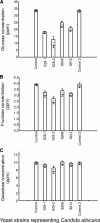External ecological niche for Candida albicans within reducing, oxygen-limited zones of wetlands
- PMID: 22247177
- PMCID: PMC3302598
- DOI: 10.1128/AEM.06343-11
External ecological niche for Candida albicans within reducing, oxygen-limited zones of wetlands
Abstract
Candida albicans within the human host is well studied; however, identifying environmental reservoirs of pathogens is epidemiologically valuable for disease management. Oxygen-limited, carbohydrate-rich zones of wetlands, to which sewage-borne C. albicans is often exposed, are characteristically similar to the gastrointestinal reservoir. Consequently, using quantitative real-time PCR (qRT-PCR) and gas chromatography-mass spectrometry (GC-MS), we demonstrated that oxygen-limited zones in polluted wetlands may act as potential reservoirs of C. albicans.
Figures



References
-
- Atlas RM. 1993. Alphabetical listing of media, p 533, 786 In Parks LC. (ed), Handbook of microbiological media. CRC Press, London, United Kingdom
-
- Efstratiou M, Mavridou A, Richardson S, Papadakis J. 1998. Correlation of bacterial indicator organisms with Salmonella spp., Staphylococcus aureus and Candida albicans in seawater. Lett. Appl. Microbiol. 26: 342–346 - PubMed
-
- Kirby CS, Thomas HM, Southam G, Donald R. 1999. Relative contributions of abiotic and biological factors in Fe(II) oxidation in mine drainage. Appl. Geochem. 14: 511–530
-
- Kurtzman CA, Fell JW. 2000. The yeasts: a taxonomic study, 4th ed, p 9–12, 476–479 Elsevier Science, Amsterdam, The Netherlands
Publication types
MeSH terms
Substances
LinkOut - more resources
Full Text Sources
Miscellaneous

